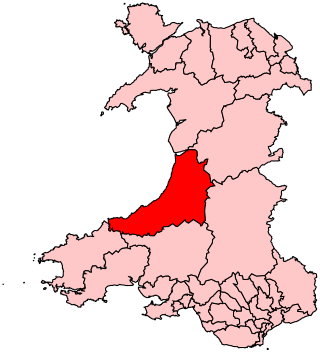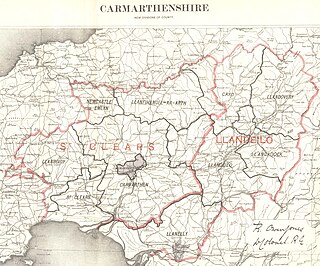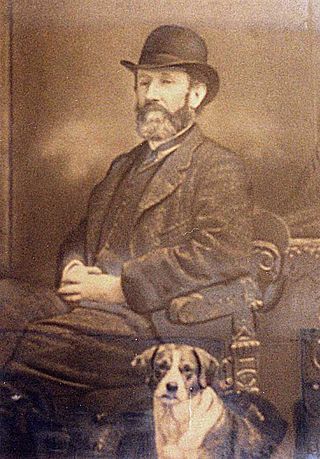Related Research Articles

Ceredigion was a parliamentary constituency represented in the House of Commons of the UK Parliament. Created in 1536, the franchise expanded in the late 19th century and on the enfranchisement of women. Its boundaries remained virtually unchanged until 1983. From 1536 until 1885 the area had two seats : a county constituency (Cardiganshire) comprising the rural areas, the other the borough constituency known as the Cardigan District of Boroughs comprising a few separate towns; in 1885 the latter was abolished, its towns and electors incorporated into the former, reduced to one MP. The towns which comprised the Boroughs varied slightly over this long period, but primarily consisted of Cardigan, Aberystwyth, Lampeter and Adpar, the latter now a suburb of Newcastle Emlyn across the Teifi, in Carmarthenshire.
The Cardigan District of Boroughs was a parliamentary constituency in Wales which returned one Member of Parliament (MP) to the House of Commons of the Parliament of the United Kingdom and its predecessors, from 1542 until it was abolished for the 1885 general election. The borough constituency comprised the four towns of Cardigan, Aberystwyth, Lampeter and Adpar - geographically separated from each other but all within the county of Cardiganshire.
Carmarthenshire was a parliamentary constituency in Wales which returned one Member of Parliament (MP) to the House of Commons of the Parliament of the United Kingdom until its representation was increased to two members for the 1832 general election.

East Carmarthenshire was a county constituency in Carmarthenshire, Wales. It returned one Member of Parliament (MP) to the House of Commons of the Parliament of the United Kingdom, elected by the first past the post voting system.

West Carmarthenshire was a parliamentary constituency in Wales which returned one Member of Parliament (MP) to the House of Commons of the Parliament of the United Kingdom.
Helston, sometimes known as Helleston, was a parliamentary borough centred on the small town of Helston in Cornwall.

William Abraham, universally known by his bardic name, Mabon, was a Welsh trade unionist and Liberal/Labour politician, and a member of parliament (MP) from 1885 to 1920. Although an MP for 35 years, it was as a trade unionist that Abraham is most well known. Initially a pioneer of trade unionism, who fought to enshrine the principle of workers' representation against the opposition of the coal-owners, he was regarded in later life as a moderate voice believing that disputes should be solved through conciliation rather than industrial action. This drew him into conflict with younger and more militant leaders from the 1890s onwards. Although the defeat of the miners in the Welsh coal strike of 1898 was a clear defeat for Mabon's strategy, his prestige was sufficient to ensure that he became the first president of the South Wales Miners' Federation which was established in the wake of the dispute. Abraham was noted for his powerful speaking voice, and was a renowned orator in English and Welsh.
Liskeard was a parliamentary borough in Cornwall, which elected two Members of Parliament (MPs) to the House of Commons from 1295 until 1832, and then one member from 1832 until 1885. The constituency was abolished by the Redistribution of Seats Act 1885.
David Pugh was a Welsh landowner and Liberal Party politician who sat in the House of Commons from 1857 until 1868 and again from 1885 until his death in 1890.

Walter Rice Howell Powell was a Welsh landowner and Liberal politician. He was Member of Parliament for Carmarthenshire from 1880 until 1885 and for West Carmarthenshire from 1885 until his death in 1889.
Charles William Nevill was a Welsh owner of a copper smelting company in Llanelli, and a Conservative Party politician. He was elected at the 1874 general election as the Member of Parliament (MP) for Carmarthen Boroughs, but resigned from Parliament two years later, accepting the Stewardship of the Chiltern Hundreds in 1876.
James Daniel Kiley was a British businessman and Liberal Party politician who served in the House of Commons from 1916 to 1922 as a Member of Parliament (MP) for constituencies in the Whitechapel area of the East End of London.
Benjamin Thomas Williams was a Welsh barrister, judge, and Liberal Party politician who sat in the House of Commons from 1878 to 1882.
The 1882 Carmarthen by-election was a parliamentary by-election held for the House of Commons constituency of Carmarthen Boroughs in West Wales on 4 January 1882.
The 1878 Carmarthen Boroughs by-election was a parliamentary by-election held for the House of Commons constituency of Carmarthen Boroughs in West Wales on 11 May 1878.

Sir Emile Algernon Arthur Keppel Cowell-Stepney, 2nd Baronet was a British landowner and Liberal politician. He was the youngest son of Sir John Stepney Cowell-Stepney (1791–1877).

Sir John Stepney Cowell-Stepney, 1st Baronet, KH (1791–1877) was a British soldier, landowner and politician. He was the elder of the two sons of General Andrew Cowell, originally of Coleshill, Buckinghamshire, and his wife Maria Justina, youngest daughter of Sir Thomas Stepney, 7th baronet of Prendergast, Pembrokeshire, and Llanelly House, Carmarthenshire. He was known as [John] Stepney Cowell until he inherited the Stepney family's estates in 1857 under the terms of the will of his uncle, Sir John Stepney, 8th baronet, when he changed the family's name to Cowell-Stepney.
The 1912 Carmarthen Boroughs by-election was a Parliamentary by-election held in the United Kingdom on 24 January 1912 for the Carmarthen Boroughs constituency in Wales. The constituency of Carmarthen Boroughs was centred on the boroughs of Carmarthen and Llanelli. It returned one Member of Parliament (MP) to the House of Commons of the Parliament of the United Kingdom, elected by the first past the post voting system.
The first election to the Carmarthenshire County Council was held in January 1889. It was followed by the 1892 election.
David Morris was a British Whig and Liberal politician, and banker.
References
- ↑ Leigh Rayment's Historical List of MPs
- ↑ British Parliamentary Election Results 1832-1885 (The Macmillan Press 1977), compiled and edited by F.W.S. Craig, page 503
- ↑ "The Election (editorial)". Welshman. 30 January 1874.
- ↑ "Editorial". Carmarthen Journal. 30 January 1874.
- 1 2 3 4 "The Representation of the Carmarthen Boroughs". Western Mail. 31 July 1876. p. 5. Retrieved 5 March 2017.
- ↑ "The Representation of the Carmarthen Boroughs". Western Mail. 1 August 1876. p. 5. Retrieved 7 March 2017.
- 1 2 "The Representation of the Carmarthen Boroughs". Western Mail. 2 August 1876. p. 5. Retrieved 9 March 2017.
- ↑ "The Representation of the Carmarthen Boroughs". Western Mail. 4 August 1876. p. 5. Retrieved 20 March 2017.
- ↑ "Editorial". Carmarthen Journal. 4 August 1876.
- ↑ Craig, F. W. S., ed. (1977). British Parliamentary Election Results 1832-1885 (hardcover) (1st ed.). London: Macmillan Press. p. 503. ISBN 978-1-349-02349-3.